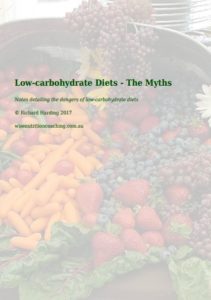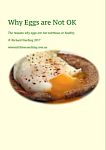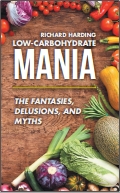Wheat and Inflammation
William Davis is largely responsible for the low-wheat, low-gluten diets with the publication of his book Wheat Belly. 1 In this book he states that we live in a ‘whole grain world’. This simply is not true.
The US guidelines for whole grains is the equivalent of four slices of whole-grain bread for males and three slices for females. 99% of the US population do not meet these guidelines. Only 10% of grains consumed are whole grains. 2
Much of the processed grain consumed comes from yeast breads, grain-based desserts, pizza bases and Mexican mixed dishes.
Popular commentators such as William Davis claims that wheat causes most of the diseases of modern civilisation and that it leads to inflammation. However, whole-grain wheat has consistently been shown to reduce inflammation in patients who are NOT suffering from CD.
Whole-grain consumption resulted in a lower PAI-1 (Plasminogen activator inhibitor-1) over a 8 week period. There was also a reduction of plasma tumor necrosis factor-α (TNF-α) after 8 weeks and increased interleukin (IL)-10, a marker of immune response, after 4 weeks. 3
PAI-1 is a marker for cardiovascular disease, metabolic syndrome, a number of cancers, thrombosis (blood clots) and obesity. It is associated with an increase in fibrinogen. 4 5 6 7
A study examined the consumption of whole grains and dietary fiber among among 902 diabetic women in the Nurses’ Health Study. Intakes of whole grains and bran were significantly associated with a decrease of the inflammation markers C-reactive protein (CRP) and tumor necrosis factor-α receptor 2 (TNF-R2). 8
A Canadian study showed that whole grain consumption is related to lower levels of PAI-1 and C-reactive protein (CRP) inflammation markers. 9
According to Esposito & Giugliano, “fiber content of a high-carbohydrate meal may influence plasma concentrations of adiponectin and interleukin 18 (IL-18): the greater the quantity of fiber in the load, the greater the inhibition of plasma IL-18 and the stimulation of adiponectin. IL-18 is a potent pro-inflammatory cytokine that may be important in the process of plaque destabilization.”
Adiponectin is an insulin-sensitizing adipocytokine with anti-inflammatory properties. 10
A study published in 2006 showed a significant inverse trend between whole-grain intake and the metabolic syndrome and mortality from cardiovascular disease. This study used data from the Nurses Study.
Fasting glucose concentrations and body mass index decreased across increasing quartile categories of whole-grain intake independent of other factors. An intake of refined grain was associated with a higher fasting glucose concentrations and a higher prevalence of the metabolic syndrome.
The average whole-grain intake of the lowest quartile was a measly 0.3 servings a day with the average of the highest quartile being 2.9 servings a day. 11
A research team lead by Alessio Fasano at the University of Maryland School of Medicine published an article in 2000 that announced the discovery of Zonulin, a protein which “induces tight junction disassembly and a subsequent increase in intestinal permeability”. 12
Increased permeability is “an early event in coeliac disease and not just a consequence of chronic intestinal inflammation.” 13
Zonulin is present in both coeliac disease and non-ceolic disease subjects but the “threshold of intestinal permeability upon gliadin exposure is not reached in non-coeliac disease“. 13
According to Dr. Michael Greger,
Dr. John McDougall writes,
Related articles
What is the Problem with Wheat?
Wheat and Inflammation
Impact of a Gluten-Free Diet
Wheat and the Distorted Views of William Davis
Last updated on Tuesday 16 January 2024 at 05:23 by administrators
Footnotes
- Davis, W. (2011) Wheat Belly. Rodale Press, Inc.
- Krebs-Smith, S. M. et al. (2010) Americans Do Not Meet Federal Dietary Recommendations. Journal of Nutrition. 140 (10), 1832–1838.
- Vitaglione, P. et al. (2015) Whole-grain wheat consumption reduces inflammation in a randomized controlled trial on overweight and obese subjects with unhealthy dietary and lifestyle behaviors: role of polyphenols bound to cereal dietary fiber. American Journal of Clinical Nutrition. 101 (2), 251–261
- Kohler, H. P. & Grant, P. J. (2000) Plasminogen-Activator Inhibitor Type 1 and Coronary Artery Disease Franklin H. Epstein (ed.). New England Journal of Medicine. 342 (24), 1792–1801.
- Juhan-Vague, I. et al. (1991) Increased plasma plasminogen activator inhibitor 1 levels. A possible link between insulin resistance and atherothrombosis. Diabetologia. 34 (7), 457–462.
- Lijnen, H. R. (2005) Pleiotropic functions of plasminogen activator inhibitor-1. Journal of Thrombosis and Haemostasis. 3 (1), 35–45.
- Huang, F. et al. (2012) Plasminogen activator inhibitor-1, fibrinogen, and lung function in adolescents with asthma and obesity. Endocrine research. 37 (3), 135–144.
- Qi, L. et al. (2006) Whole-grain, bran, and cereal fiber intakes and markers of systemic inflammation in diabetic women. Diabetes Care. 29 (2), 207–211
- Masters, R. C. et al. (2010) Whole and Refined Grain Intakes Are Related to Inflammatory Protein Concentrations in Human Plasma. Journal of Nutrition. 140 (3), 587–594.
- Esposito, K. & Giugliano, D. (2006) Whole-grain intake cools down inflammation. The American Journal of Clinical Nutrition. 83 (6), 1440
- Sahyoun, N. R. et al. (2006) Whole-grain intake is inversely associated with the metabolic syndrome and mortality in older adults. The American Journal of Clinical Nutrition. 83 (1), 124–131.
- Fasano, A. et al. (2000) Zonulin, a newly discovered modulator of intestinal permeability, and its expression in coeliac disease. The Lancet. 355 (9214), 1518–1519.
- Drago, S. et al. (2006) Gliadin, zonulin and gut permeability: Effects on celiac and non-celiac intestinal mucosa and intestinal cell lines. Scandinavian Journal of Gastroenterology. 41 (4), 408–419.
- Greger, Dr Michael; Greger, Michael; Stone, Gene. How Not To Die: Discover the foods scientifically proven to prevent and reverse disease. Pan Macmillan UK. Kindle Edition.
- McDougall, J. (2014) The Smoke and Mirrors behind Wheat Belly and Grain Brain [online]. Available from: https://www.drmcdougall.com/misc/2014nl/jan/smoke.htm (Accessed 15 November 2016).





